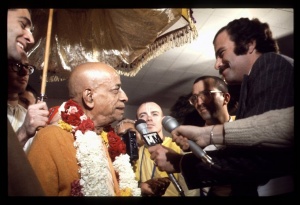CC Adi 10.124-126 (1975): Difference between revisions
(Vanibot #0027: CCMirror - Mirror CC's 1996 edition to form a basis for 1975) |
(Vanibot #0020: VersionCompareLinker - added a link to the Version Compare feature) |
||
| Line 2: | Line 2: | ||
<div style="float:left">'''[[Sri Caitanya-caritamrta (1975)|Śrī Caitanya-caritāmṛta (1975)]] - [[CC Adi (1975)|Ādi-līlā]] - [[CC Adi 10 (1975)|Chapter 10: The Trunk, Branches and Subbranches of the Caitanya Tree]]'''</div> | <div style="float:left">'''[[Sri Caitanya-caritamrta (1975)|Śrī Caitanya-caritāmṛta (1975)]] - [[CC Adi (1975)|Ādi-līlā]] - [[CC Adi 10 (1975)|Chapter 10: The Trunk, Branches and Subbranches of the Caitanya Tree]]'''</div> | ||
<div style="float:right">[[File:Go-previous.png|link=CC Adi 10.123 (1975)|Ādi-līlā 10.123]] '''[[CC Adi 10.123 (1975)|Ādi-līlā 10.123]] - [[CC Adi 10.127 (1975)|Ādi-līlā 10.127]]''' [[File:Go-next.png|link=CC Adi 10.127 (1975)|Ādi-līlā 10.127]]</div> | <div style="float:right">[[File:Go-previous.png|link=CC Adi 10.123 (1975)|Ādi-līlā 10.123]] '''[[CC Adi 10.123 (1975)|Ādi-līlā 10.123]] - [[CC Adi 10.127 (1975)|Ādi-līlā 10.127]]''' [[File:Go-next.png|link=CC Adi 10.127 (1975)|Ādi-līlā 10.127]]</div> | ||
{{CompareVersions|CC|Adi 10.124-126|CC 1975|CC 1996}} | |||
{{RandomImage}} | {{RandomImage}} | ||
| Line 20: | Line 21: | ||
<div class="synonyms"> | <div class="synonyms"> | ||
nīlācale—in Jagannātha Purī; prabhu-saṅge—in the company of Lord Caitanya; yata—all; bhakta-gaṇa—devotees; sabāra—of all of them; adhyakṣa—the chief; prabhura—of the Lord; marma—heart and soul; dui jana—two persons; | nīlācale—in Jagannātha Purī; prabhu-saṅge—in the company of Lord Caitanya; yata—all; bhakta-gaṇa—devotees; sabāra—of all of them; adhyakṣa—the chief; prabhura—of the Lord; marma—heart and soul; dui jana—two persons; paramānanda-purī—of the name Paramānanda Purī; āra—and; svarūpa-dāmodara—of the name Svarūpa Dāmodara; gadādhara—of the name Gadādhara; jagadānanda—of the name Jagadānanda; śaṅkara—of the name Śaṅkara; vakreśvara—of the name Vakreśvara; dāmodara paṇḍita—of the name Dāmodara Paṇḍita; ṭhākura haridāsa—of the name Ṭhākura Haridāsa; raghunātha vaidya—of the name Raghunātha Vaidya; āra—and; raghunātha-dāsa—of the name Raghunātha dāsa. | ||
</div> | </div> | ||
| Line 27: | Line 28: | ||
<div class="translation"> | <div class="translation"> | ||
Among the devotees who accompanied the Lord in Jagannātha Purī, two of | Among the devotees who accompanied the Lord in Jagannātha Purī, two of them-Paramānanda Purī and Svarūpa Dāmodara-were the heart and soul of the Lord. Among the other devotees were Gadādhara, Jagadānanda, Śaṅkara, Vakreśvara, Dāmodara Paṇḍita, Ṭhākura Haridāsa, Raghunātha Vaidya and Raghunātha dāsa. | ||
</div> | </div> | ||
==== PURPORT ==== | ==== PURPORT ==== | ||
<div class="purport"> | <div class="purport"> | ||
The Caitanya-bhāgavata, Antya- | The Caitanya-bhāgavata, Antya-līlā, Chapter Five, states that Raghunātha Vaidya came to see Śrī Caitanya Mahāprabhu when the Lord was staying at Pāṇihāṭī. He was a great devotee and had all good qualities. According to the Caitanya-bhāgavata, he was formerly Revatī, the wife of Balarāma. Anyone he glanced upon would immediately attain Kṛṣṇa consciousness. He lived on the seashore at Jagannātha Purī and compiled a book of the name Sthāna-nirūpaṇa. | ||
</div> | </div> | ||
Latest revision as of 14:06, 26 January 2020

A.C. Bhaktivedanta Swami Prabhupada
TEXTS 124-126
- nīlācale prabhu-saṅge yata bhakta-gaṇa
- sabāra adhyakṣa prabhura marma dui-jana
- paramānanda-purī, āra svarūpa-dāmodara
- gadādhara, jagadānanda, śaṅkara, vakreśvara
- dāmodara paṇḍita, ṭhākura haridāsa
- raghunātha vaidya, āra raghunātha-dāsa
SYNONYMS
nīlācale—in Jagannātha Purī; prabhu-saṅge—in the company of Lord Caitanya; yata—all; bhakta-gaṇa—devotees; sabāra—of all of them; adhyakṣa—the chief; prabhura—of the Lord; marma—heart and soul; dui jana—two persons; paramānanda-purī—of the name Paramānanda Purī; āra—and; svarūpa-dāmodara—of the name Svarūpa Dāmodara; gadādhara—of the name Gadādhara; jagadānanda—of the name Jagadānanda; śaṅkara—of the name Śaṅkara; vakreśvara—of the name Vakreśvara; dāmodara paṇḍita—of the name Dāmodara Paṇḍita; ṭhākura haridāsa—of the name Ṭhākura Haridāsa; raghunātha vaidya—of the name Raghunātha Vaidya; āra—and; raghunātha-dāsa—of the name Raghunātha dāsa.
TRANSLATION
Among the devotees who accompanied the Lord in Jagannātha Purī, two of them-Paramānanda Purī and Svarūpa Dāmodara-were the heart and soul of the Lord. Among the other devotees were Gadādhara, Jagadānanda, Śaṅkara, Vakreśvara, Dāmodara Paṇḍita, Ṭhākura Haridāsa, Raghunātha Vaidya and Raghunātha dāsa.
PURPORT
The Caitanya-bhāgavata, Antya-līlā, Chapter Five, states that Raghunātha Vaidya came to see Śrī Caitanya Mahāprabhu when the Lord was staying at Pāṇihāṭī. He was a great devotee and had all good qualities. According to the Caitanya-bhāgavata, he was formerly Revatī, the wife of Balarāma. Anyone he glanced upon would immediately attain Kṛṣṇa consciousness. He lived on the seashore at Jagannātha Purī and compiled a book of the name Sthāna-nirūpaṇa.